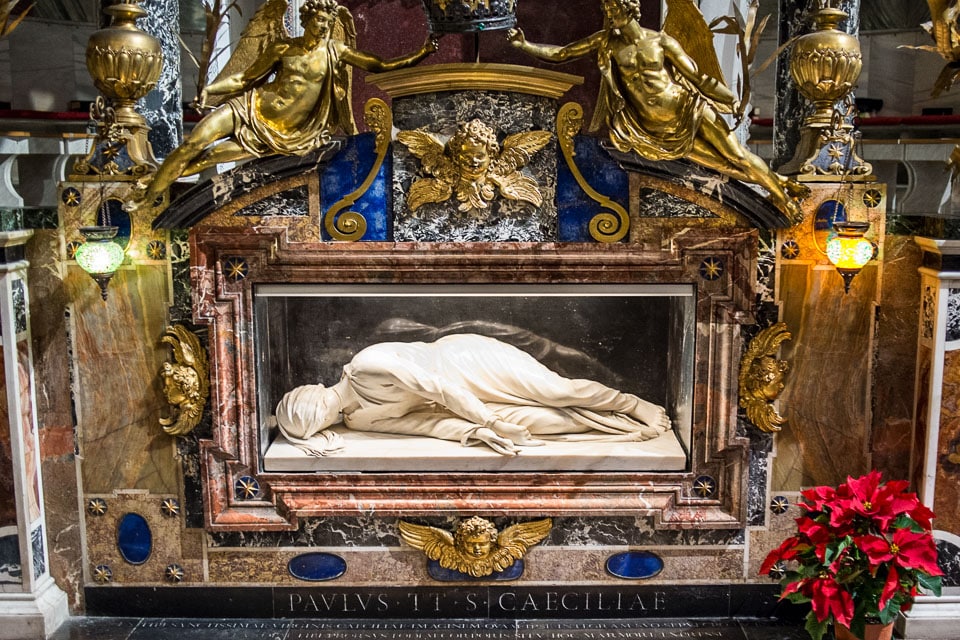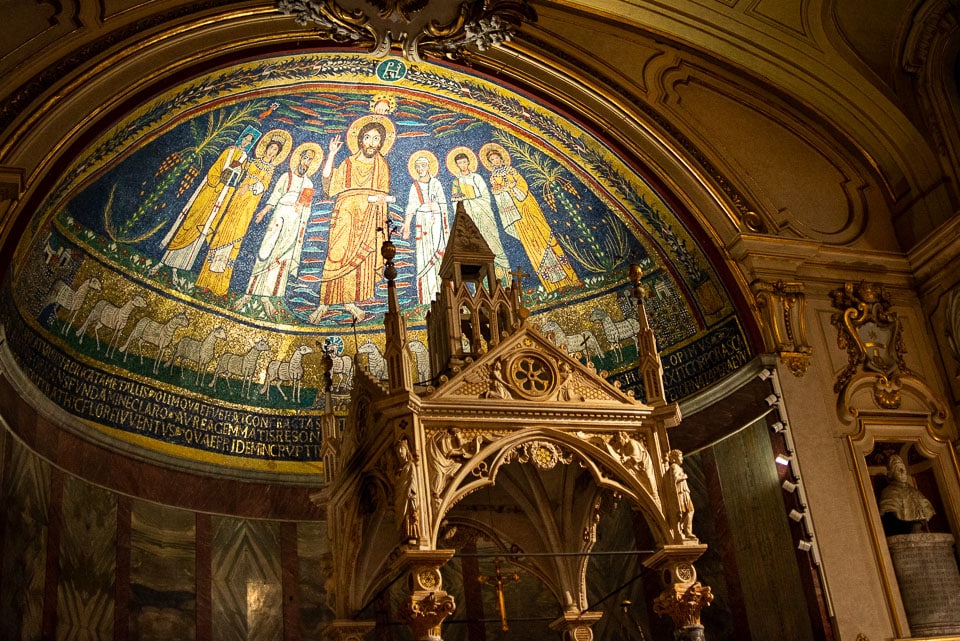
I can clearly remember the first time I saw the Basilica of Saint Cecilia, (Basilica di Santa Cecilia in Trastevere.) It was in 2000, and I was studying Latin in Rome for two months. And so I had plenty of time to wander Rome poking my head into random churches and other ancient sites. That's just what I was doing when I came upon this small church near the Tiber river in Trastevere.
I was vaguely aware of the story of Saint Cecilia. She was a Roman citizen, martyred for her faith in the 3rd Century. She's the patron saint of musicians.
According to the story, despite Cecilia's vow of virginity, her parents forced her to marry a pagan nobleman named Valerian, who later also converted to Christianity and was also martyred. On the wedding night, Cecilia sat apart singing to God in her heart. Because of that, she was declared the patron saint of musicians.
The martyrdom of Cecilia is said to have followed that of her husband Valerian and his brother at the hands of the Roman prefect Turcius Almachius.The legend about Cecilia's death says that after being struck three times on the neck with a sword, she lived for three days.
St. Cecilia was originally buried in the Catacombs of St. Callixtus and later transferred to the Basilica of Santa Cecilia.
Again, according to the story, before the Roman executioner cut her throat, Cecilia asked that her home be turned into a church. The church that stands on Piazza di Santa Cecilia in the Trastevere rione of Rome traces its history back to that time, so it's possible that this was the site of her family home.
The first church on this site was founded probably in the 3rd century, by Pope Urban I, and was devoted to Cecilia. The baptistery associated with this church, together with the remains of a Roman house of the early Empire, was found during some excavations under the church.
The Church of Santa Cecilia has undergone many renovations since then, and today the interior features art from the 9th to 17th Centuries. But the most stunning artifact is the marble statue in front of the main altar. The statue of the saint, by the late Renaissance sculptor Stefano Maderno is enclosed in a glass case.
A marble slab in the pavement in front of the case, quotes Maderno's sworn statement that he has recorded the body as he saw it when the tomb was opened in 1599. The statue depicts the three axe strokes described in the 5th-century account of her martyrdom.
As the legend goes, the tomb of Cecilia was opened during renovations of the church in 1599, and Cecilia's body was found to be uncorrupted. The Cardinal in charge of the renovation commissioned Maderno to reproduce the body just as it had been found. Believe the legend or not, this was the result.
If you know the baroque style of sculpture of the age, Maderno's statue of Cecilia lives in sharp contrast to the exaggerated vivacity of other contemporary works. The peaceful repose, with the demurely turned head and the clearly visible slice in her neck, emphasize a serenity at the time of death that touches the heart. After this, all the Baroque sculpture of Bernini and others is just conceit.
Put simply, Maderno's remarkable work is my favorite sculpture in all of Rome.

Also worth an extended look is the Byzantine style apse mosaic from the 9th Century that hovers over the 13th Century Gothic ciborium that covers the altar of the Maderno sculpture. The ancient mosaic represents Christ the Redeemer with other Roman saints Paul, Cecilia, Pope Paschal I, Peter, Cecilia's husband Valerian, and Agatha.
A full, poetic telling of the story of Saint Cecilia can be found in the Second Nun's Tale of Chaucer's Canterbury Tales.
P.S. Another interesting note about Saint Cecilia as the patron of musicians: it's said that Simon and Garfunkel's song Cecilia is about the difficulty of songwriting.
The Church of Saint Cecilia is one of our 28 recommended things to do in Rome.
Up Your Travel Skills
Looking to book your next trip? Use these resources that are tried and tested by us. First, to get our best travel tips, sign up for our email newsletter. Then, be sure to start your reading with our Resources Page where we highlight all the great travel companies and products that we trust. Travel Accessories: Check out our list of all the accessories we carry to make getting there and being there a lot easier. Credit Cards: See our detailed post on how to choose the right travel rewards credit card for you. Flights: Start finding the very best flight deals by subscribing to Thrifty Traveler. Book your Hotel: Find the best prices on hotels with Booking.com. See all of the gear and books we like in one place on our Amazon shop.Got a comment on this post? Join the conversation on Facebook, Instagram, or Threads and share your thoughts!



Comments are closed.